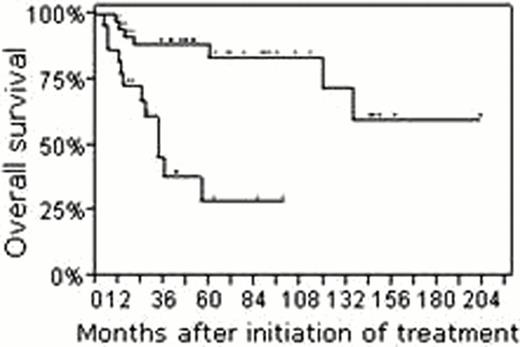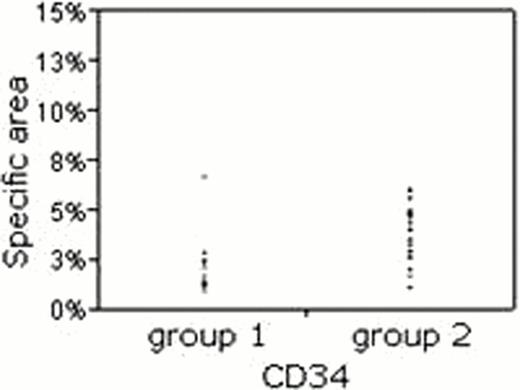Abstract
Abstract 2696
Follicular lymphoma (FL) has considerable clinical heterogeneity. There is a need for easily quantifiable prognostic biomarkers. There is no consensus on the prognostic significance of microvessel density.
Characterize the blood and lymphatic vessel density of tumor tissue basing on immunohistochemical study (IHC) of sections from paraffin blocks of lymph nodes biopsies in two groups of patients with different clinical course.
The study included 59 patients with follicular lymphoma: 39 women (67%) and 20 men (33%). The mean and median age was 53 years (range: 27–83 years). 49 patients were observed in the National Research Center for Hematology (Moscow) from April 2001 to May 2011 and 10 patients – in Cancer Research Center (Moscow) at the same period of time. The first group (1) included 28 patients followed during 2 years or more without therapy; with remission of the underlying disease; with relapse in five or more years from the start of their treatment (late relapse). The second group (2) included 31 patients who died due to tumor progression in the first 1–2 years from time of putting this diagnosis; with resistance to the passage of the tumor; with relapsed FL in the first year from the start of treatment (early relapse). Patients in both groups received the same initial treatment. Vascularization of tumor tissue was assessed by IHC on sections from paraffin blocks of tumor biopsies of lymph nodes from the visualization of blood and lymphatic vessels using antibodies CD34 and D2–40. CD34 is an endothelial marker of blood vessels. D2–40 is a novel monoclonal antibody to an Mr 40,000 O-linked sialoglycoprotein that reacts with a fixation-resistant epitope on lymphatic endothelium. Morphometric analysis was performed using light microscopy and a digital camera Leica (vol. × 40). The pictures are processed by a computer program “VideoTesT-Morphology 5.2” in order to estimate the specific area of vessels in relation to the tumor tissue (%) during visual inspection of the researcher. IHC-specimen evaluation was carried out using a table of random numbers.
5-year OS rate in group 1 was significantly higher than in group 2 (83±7% vs 28±13%; ð=0,03) (Figure 1). Evaluation of the specific area of blood and lymph vessels was conducted in two comparable groups. The specific area of blood vessels in group 2 was significantly higher than in group 1: 0,04 (95% CI, 0,03–0,05) vs 0,02 (95% CI, 0,01–0,03) (Figure 2). The specific area of the lymph vessels in group 2 was significantly higher than in group 1: 0,06 (95% CI, 0,04–0,07) vs 0,03 (95% CI, 0,01–0,04) (Figure 3).
The microvascular density can be estimated using the markers CD34 and D2–40. Our results demonstrate an association between prognosis and angiogenic sprouting and revealed higher angiogenic activity in the poor prognostic group.
No relevant conflicts of interest to declare.
Author notes
Asterisk with author names denotes non-ASH members.




This feature is available to Subscribers Only
Sign In or Create an Account Close Modal